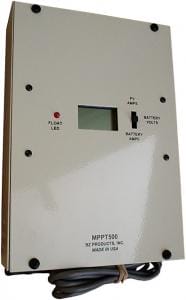Currently the most common charge controllers are Pulse width Modulation(PWM) charge controllers which simulates a variable current by switching a full current On and OFF at high speed for varying lengths of time. A Maximum Power Point tracking (MPPT) charge controller is a charge controller that operates the solar array at its maximum power point under a range of operating conditions as well as regulating battery charging.
The interesting features of the MPPT technology is that it usually allows you to
have a solar panel array with a much higher voltage than your battery bank's voltage.
The MPPT charge controller will automatically and efficiently convert the higher voltage
down to the lower voltage.
A big advantage to having a higher voltage solar panel array is that you can use smaller
gauge wiring to the charge controller. And since a solar panel array can sometimes be
over a 100 feet away from the charge controller, keeping the cost of the wiring down to
a minimum is usually an important financial goal for the whole project. When you double
the voltage (e.g. from 12 to 24 volts), you will decrease the current going through the
wires by half which means you use a quarter as much copper (or cable with half of the
diameter).
What is the difference between MPPT and PWM charge controllers

